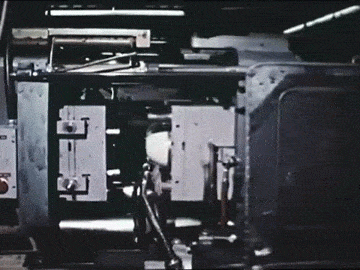Institution: Internet Archive
Collection: Prelinger Archives
Running time: 28m54s
Source film: 35mm; color; sound
Year: 1959 / ca. 1964
Director: George Yarbrough
Narrator: Russ Blair
Production: United Film Productions (Orlando, Florida)
Writers: Patrick E. Tahaney, Harry Whittington, George Yarbrough
Camera: Russ Blair
We’re fast-approaching the season of stuffed birds, holiday hams, and mountains of mashed root vegetables. Shortly thereafter comes the season of leftovers of every shape, species, and viscosity. The modern food preservation movement and virtually every brand of food storage container on the market can be traced back to Tupperware. As the plastics industry exploded following World War II, Tupperware rose from humble origins in Leominster, Massachusetts to dominate the home product market through an in-home “party” sales method.
As any plastic storage container historian can tell you — and who isn’t these days? — there could be no Tupperware without the synthetic polymers of polystyrene and polyethylene, and neither of them could exist without petroleum. And as the animated beginning of The Wonderful World of Tupperware would have us believe, there’s no petroleum without dinosaurs (an idea largely since debunked). The polymers arrived as tiny pellets in massive train shipments and were then tested for melt, weight, and a variety of other traits. If the sample passed, the shipments moved on to the Tupperware factory through a series of pneumatic tubes.
Whatever pre-existing notions you may have had about where Tupperware came from will be flipped by over 20 minutes of production processes, from the sketch artists’ renderings of unique shapes (um… bowls) to the various molding stages and quality checks, and even the cruel removal of each bowl’s sprue (akin to the terrible practice of tail docking). Was there ever a stage where the company president tore up a container design and threw the shards in the creator’s face while cursing? If so, it was not depicted in this comprehensive presentation of the product line’s early life.
The production value is fairly high with this film, as evidenced by the thoughtful scenarios and cinematography. The film’s opening features a keyhole shot into an ethylene processing facility, and the filmmakers use plenty of close and medium shots to show steps within each production process. The real showstopper was a shot in which the camera is mounted at the center of an automated device called the “uni-make,” which was designed to remove products from molding machines. No one will confuse this for the work of Christopher Doyle or Gordon Willis, but it was a nice surprise to see this level of attention given to how things looked.

This film isn’t just notable for its solid technique and inventive camera angles, though. The last section of the narrative focuses on the annual Jubilee event, a sales convention used to dole out achievement awards and material forms of recognition (e.g. fur coats, tiaras, and even cars). Every major convention needs entertainment, and this one had it in spades. Awkward, disturbing spades. Johnny Desmond tailors a version of “Hello, Dolly” for the Tupperware sales crowd while kissing random women seated at tables and goading them into kissing him back. Former 1959 Miss Universe runner-up Anita Bryant gives a similar performance in a celebrity-product pairing that Tupperware would probably rather forget in light of her four decades of anti-gay crusading that would follow.
The controversy doesn’t end there. Despite the 1959 date asserted by the film’s IMDb page, several commenters in various outlets have remarked that certain indicators — a Ford Mustang giveaway, the singing of “Hello, Dolly,” and even the observed machinery — make it unlikely that the film was released before 1964. Prelinger’s title list, last updated in 2010, doesn’t clear the air, as there’s no production year listed for the film. Most telling is the “Land of Ours Jubilee” 16mm film which notes the Anita Bryant appearance, one of several promotional Tupperware films in the Ann and Thomas Damigella Collection, 1951-1997, held at the Smithsonian Institution. This seems a case where historians may be better served by an amalgamation of other release information instead of more official sources.
In a discovery that will delight me and perhaps few others, producer and director George Yarbrough went on to serve as the editor and sound mixer for 1971’s Zaat, a science-fiction horror about a bipedal killer fish filmed entirely in northern Florida.
Related

